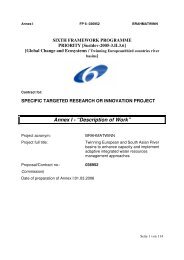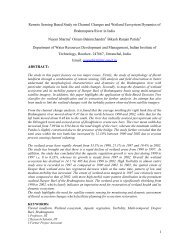WP 5 Analysis of present IWRM practices - Brahmatwinn
WP 5 Analysis of present IWRM practices - Brahmatwinn
WP 5 Analysis of present IWRM practices - Brahmatwinn
You also want an ePaper? Increase the reach of your titles
YUMPU automatically turns print PDFs into web optimized ePapers that Google loves.
The table and the chart below show that the major part <strong>of</strong> consumptive water in southern Germany<br />
is used for public water supply, but the water demand <strong>of</strong> the industrial sector is high as well. The<br />
sector agriculture has comparatively just a small water demand. In the twinning Asian basin the<br />
situation is different to this. For hydropower there is a large amount <strong>of</strong> water necessary. But this<br />
water is added to the stream system again. Consequently the losses are not significant.<br />
Water extraction for water using sectors in mio.m3<br />
Agriculture;<br />
1,76<br />
Industry; 747,3<br />
Public water<br />
supply; 791,4<br />
Public heat<br />
power plants;<br />
2229,3<br />
Fig. 3: Water extraction in the German DRB in 2001<br />
The largest percentage <strong>of</strong> water extraction lies in the federal state Bavaria, because the Danube River<br />
basin reaches here into a large part and 65% <strong>of</strong> the Bavarian population is living in the Danube River<br />
basin, including the population <strong>of</strong> the agglomeration Munich and a few other large cities.<br />
The per capita water consumption in the German Danube basin was fallen during the last decades.<br />
Major reason is the rising water price, but also more efficient technologies and in industry multiuses<br />
by water cycles. Today 136 l per person and day were consumed. The public water supply comprises<br />
domestic use and small trade in addition to public institutions. Issues <strong>of</strong> interest are in this context a<br />
changing population number and the development <strong>of</strong> the person oriented water demand. These two<br />
aspects have a significant influence to the prospective water demand <strong>of</strong> the end user.<br />
The water for drinking water supply is to 95% extracted from ground- and spring water (see table).<br />
98% <strong>of</strong> the population has access to the public water supply, 93% are connected with the sewage<br />
water system.<br />
Waste water discharges back through municipal waste water treatment plants as well as through<br />
direct sewage disposal <strong>of</strong> manufacturing industry and public thermal power plants. In 2001 about 4<br />
billion m 3 waste water discharged back.<br />
In total the water use in this sector was about 790 Mio m 3 in 2001. Following the sector public water<br />
supply can be described as one <strong>of</strong> the major water users.<br />
In Austria about 40% <strong>of</strong> extracted fresh water is used for public water supply. The water is extracted<br />
to similar parts <strong>of</strong> ground and spring water sources. The total water use in the Salzburger Land<br />
8





